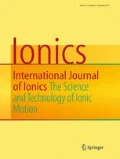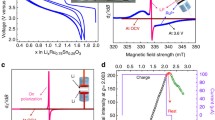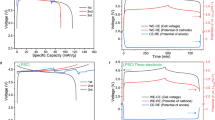Abstract
The growth and evolution of the interphase, due to contact with the ambient atmosphere or electrolyte, are followed using 7Li magic-angle spinning nuclear magnetic resonance (MAS NMR) in the case of two materials amongst the most promising candidates for positive electrodes for lithium batteries: LiFePO4 and LiMn0.5Ni0.5O2. The use of appropriate experimental conditions to acquire the NMR signal allows observing only the «diamagnetic» lithium species at the surface of the grains of active material. The reaction of LiMn0.5Ni0.5O2 with the ambient atmosphere or LiPF6 (1 M in Ethylene Carbonated/DiMéthyl Carbonate (EC/DMC)) electrolyte is extremely fast and leads to an important amount of lithium-containing diamagnetic species compared to what can be observed in the case of LiFePO4. The two studied materials display a completely different surface chemistry in terms of reactivity and/or kinetics of the surface towards electrolyte. Moreover, these results show that MAS NMR is a very promising tool to monitor phenomena taking place at the interface between electrode and electrolyte.
Similar content being viewed by others
Introduction
The development of portable electronic devices and the need to maintain a clean environment by reducing the pollution from motorized vehicles have led to much research in the lithium-ion battery field. Over recent years, numerous studies have focused on new positive-electrode materials for lithium cells and in particular on open-structure layered transition metal oxides such as LiNi1/2Mn1/2O2 [1–8] as well as the phospho-olivine LiFePO4 [9–17]. The characterization of the electrochemical properties as well as the monitoring of the evolution of these materials, along the electrochemical cycling and/or storage, represent an important step in the performance-improvement process. Interfacial reactions and the growth of a passivation layer at the electrode surface upon cycling have been also evidenced for different positive-electrode materials [18, 19] and have been identified of paramount importance as they can lead to performance degradation of the battery upon aging and cycling. However, the experimental conditions of formation, growth, and modification as well as the intimacy of the interactions between the surface layer and the surface of active material is still ambiguous.
Solid-state nuclear magnetic resonance (NMR), as a local probe, is an extremely convenient tool to gather information on the chemical and structural local environment of nuclei under observation (6Li, 7Li, 1H…etc). This technique has been recently successfully applied to the characterization of host matrix of lithium-intercalation compounds, complementary to electrochemical impedance spectroscopy measurements and to long-range probes such as X-ray diffraction as well as surface probes such as X-ray photoelectron spectroscopy (XPS). Nevertheless, surface layers have been very rarely observed by magic-angle spinning NMR (MAS NMR). To our knowledge, it has been recently applied to the observation of interphase layers on Li(Ni1-y-z Co y Al z )O2 positive electrodes of lithium-ion batteries [20] and of solid electrolyte interphase on LiCoO2 and graphitic carbon electrodes [21], as well as on moisture contamination on substituted LiMn2O4 spinel-type compounds [22].
In the present work, information on the growth and evolution of the interphase are gathered in the case of contact with ambient atmosphere and LiPF6 (1 M in EC/DMC) electrolyte for two materials amongst the most promising candidates for positive electrodes for lithium batteries: LiFePO4 and LiNi1/2Mn1/2O2.
Experimental
The LiNi1/2Mn1/2O2 samples used for this study have been obtained through the classic coprecipitation method described elsewhere [1, 2]. The LiFePO4 samples were synthesized through a solution method [23] yielding olivine grains without any carbon coating.
7Li NMR measurements were carried out at room temperature on a Bruker Avance-500 spectrometer (B0 = 11.8 T, Larmor frequency ν 0 = 194.369 MHz in 7Li resonance). Single-pulse MAS spectra were obtained by using a Bruker MAS probe with a cylindrical 4-mm o.d. zirconia rotor. Spinning frequencies up to 14 kHz were utilized. A short single-pulse length of 1 μs corresponding to a non-selective π/2 pulse or a rotor synchronized (π/2-τ-π-τ-acq.) echo sequence, where τ = 1/ν r and ν r is the spinning frequency, were used. Recycle time was in the 0.5–60 s range, and a spectrometer dead time (preacquisition delay) of 4.5 μs was used before each acquisition. The isotropic shifts, reported in parts per million, are relative to an external powder sample of LiCl set at 0 ppm. The spectra displayed in this work were normalized, taking into account the number of scans and the mass of sample.
Results and discussion
The scanning electron microscopy (SEM) pictures of the two synthesized materials are displayed in Fig. 1. The estimated grain size is slightly different for the two materials (0.3 and 1 μm for LiNi1/2Mn1/2O2 and LiFePO4, respectively). The specific surface area has been measured using Brunauer–Emmett–Teller method and yielded 4 and 5 m2/g for LiNi1/2Mn1/2O2 and LiFePO4, respectively. To follow the evolution of a possible passivation layer on the surface of the grains of active materials (LiNi1/2Mn1/2O2 and LiFePO4) using 7Li MAS NMR, and considering that two different compounds with different molecular weights will be compared, it appears appropriate to normalize the detected intensities, not only with respect to the mass of sample put in the NMR rotor as it is usually done, but also to specific surface area of the sample. Therefore, in the following, NMR spectra will be shown as intensity per square meter which is not the unit typically used but the most rigorous in our case. It has to be also noted that none of these materials is carbon-coated, and therefore, there is no contribution of such an extra phase at the surface of the active material.
Figure 2 displays 7Li MAS NMR spectra for LiNi0.5Mn0.5O2 stored in ambient atmosphere for 2 months acquired with a Hahn-echo pulse sequence (Fig. 2a), with a single-pulse sequence (Fig. 2b), and LiFePO4 stored in ambient atmosphere for 2 months acquired with a single-pulse sequence (Fig. 2c). In echo conditions, a broad signal with a significant hyperfine shift is observed. It is assigned to Li ions present in the active material. The dipolar interaction between Li and paramagnetic transition metals is too strong to be averaged out under 14-kHz MAS conditions with the 500-MHz spectrometer used for these experiments. Using a single pulse with a dead time longer than the T 2 of this signal allows observing only the «diamagnetic» Li at the surface [20].
This feature, in particular, makes MAS NMR a very convenient tool for scanning surface species without interference or parasite signal coming from the bulk. The broad and featureless signal as well as the important set of intense sidebands is due to the extremely strong paramagnetism and the proximity of the bulk made of LiNi1/2Mn1/2O2 or LiFePO4. Indeed, the line width of the sidebands is much broader than the typical quadrupolar shape of Li2CO3 alone (not shown), which does not contain any paramagnetic ion. The intensity of the sidebands reflects both a strong dipolar interaction with paramagnetic centers distributed around the nucleus under observation and the overall paramagnetism of the active material of the electrode seen by the surface layer secondary phase. As the dipolar interaction scales with the distance as 1/r 3 (where r is the distance between the nucleus under observation and the discrete paramagnetic center), the line width of the signal and the intensity of the sidebands can be used as a probe of the intimacy between the bulk and the diamagnetic surface layer [24].
The use of appropriate experimental NMR conditions, i.e., a nonselective pulse allowing the excitation of all lithium nuclei and a long-enough recycle delay between each pulse (typically between 0.5 and 60 s), allows a quantitative observation of the signal. The much-lower integrated intensity detected on the 7Li MAS NMR spectrum of LiFePO4 after 2 months of contact with the ambient atmosphere indicates clearly the high stability of the grain surface of olivine towards the atmosphere compared to the layered lithium nickel manganese oxide. As a matter of fact, the latter displays an amount of signal that is at least 40 times larger than that observed for the olivine. An accurate estimation is quite tricky due to the low amount of surface species that can be seen on the grains of LiFePO4 leading to a very low signal to noise ratio, but the difference between the two spectra seen in Fig. 1 leaves no ambiguity as for the difference in surface reactivity of the two compounds. Such observation is in perfect agreement with previous results obtained using different techniques such as XPS and Fourier transform infrared (FTIR) [25–29].
In a second step, the two materials have been soaked in electrolyte for different amounts of time to evaluate the reactivity of each compound, leading to a possible passivation layer. Figure 3 shows the 7Li MAS NMR spectra obtained in the case of the layered lithium nickel manganese oxide. The comparison of the spectrum of the pristine sample and that recorded after 30 s of soaking illustrates the fast kinetics of the reaction between the active material and the electrolyte. The subsequent spectra obtained after 5 min, 1 h, and 2 weeks do not show any significant variation in the integrated intensity, indicating that the reaction is almost complete after 30 s. It has to be noted that the formation of the detected surface species could be even faster, but 30 s represents the minimum of time needed to soak the sample in the electrolyte and to recover it by centrifugation. In comparison, Fig. 4 displays 7Li MAS NMR spectra obtained in the case of the lithium iron phosphate. After 1 month of contact with the electrolyte, the signal detected still slowly evolves, suggesting that the reaction is not yet finished and thus that the passivation reaction is much slower compared to the case of the LiNi1/2Mn1/2O2. Moreover, the integrated intensity obtained for LiFePO4 after 2 weeks of contact with the electrolyte is much lower than that detected for LiNi1/2Mn1/2O2 (Fig. 5). This confirms previous results concerning the higher stability of LiFePO4 compared to LiNi1/2Mn1/2O2 and their different surface chemistry [25–30], as suggested by XPS or FTIR.
In addition, present results demonstrate an important difference in terms of kinetics of surface reaction. The two studied materials, LiNi1/2Mn1/2O2 and LiFePO4, display different surface structures, chemistries, and morphologies. Such differences may explain different catalytic activity toward the components of the electrolyte, thus leading to different surface reactivity and kinetics. For now, it is still difficult to unravel the precise reasons of a faster kinetics other than the general reasons cited above. Such a purpose is beyond the scope of this paper, considering the complexity of the studied systems. Nevertheless, these results confirm that surface phenomena are clearly a major factor to be considered to better understand the electrochemical behavior of cathode materials for lithium batteries.
Conclusions
The formation and the growth of surface species have been followed using 7Li MAS NMR in the case of LiNi1/2Mn1/2O2 and LiFePO4 in contact with the ambient atmosphere and a 1 M LiPF6 in EC/DMC electrolyte. This technique allows, in particular, a quantitative and selective observation of the lithium species present at the surface without additional signal coming from the bulk of the active material. This makes MAS NMR a very promising tool to monitor phenomena taking place at the interface between electrode and electrolyte in lithium batteries. The reaction of the layered oxide with the ambient medium, atmosphere, or electrolyte, is extremely fast and leads to an important amount of lithium containing diamagnetic species compared to what can be observed in the case of the iron phosphate. In addition, in the case of the latter compound and from the progressive evolution of the NMR signal, it can be deduced that the kinetics of the reaction is slower as the intensity of the signal still seems to increase after 1 month of contact with the electrolyte. Therefore, the two studied materials display a completely different surface chemistry, not only in terms of chemical nature of the reaction products, as it has been shown in previous XPS and FTIR studies, but also in terms of reactivity and/or kinetics of the surface reactivity towards electrolyte. Further experiments are obviously needed to obtain more accurate information, in particular on the interaction between the surface species and the bulk material as well as on the evolution of the surface species along the electrochemical cycling.
References
Makimura Y, Ohzuku T (2003) J Power Sources 156:119
Lu Z, Beaulieu LY, Donaberger RA, Thomas CL, Dahn JR (2002) J Electrochem Soc 149(6):A778
Yoon WS, Paik Y, Yang XQ, Balasubramanian M, McBreen J, Grey CP (2002) Electrochem Solid-State Lett 5(11):A263
Johnson CS, Kim JS, Kropf AJ, Kahaian AJ, Vaughey JT, Fransson LML, Edström K, Thackeray MM (2003) Chem Mater 15(12):2313
Bréger J, Dupré N, Chupas PJ, Lee PL, Proffen T, Parise JB, Grey CP (2005) J Am Chem Soc 127(20):7529
Li HH, Yabuuchi N, Meng YS, Kumar S, Breger J, Grey CP, Yang SH (2007) Chem Mater 19(10):2551
Hinuma Y, Meng YS, Kang K, Ceder G (2007) Chem Mater 19(7):1790
Breger J, Jiang M, Dupré N, Meng YS, Yang SH, Ceder G, Grey CP (2005) J Solid State Chem 178(9):2575
Andersson A, Kalska B, Häggström L, Thomas JO (2000) Solid State Ionics 130(1–2):41
Dominko R, Goupil JM, Bele M, Gaberscek M, Remskar M, Hanzel D, Jamnik J (2006) J Power Sources 153:274
Striebel K, Shim J, Srinivasan V, Newman J (2005) J Electrochem Soc 152(4):A664
Chen G, Song X, Richardson TJ (2007) J Electrochem Soc 154(7):A627
Zaghib K, Mauger A, Goodenough JB, Gendron F, Julien CM (2007) Chem Mater 19(15):3740
Wilcox JD, Doeff MM, Marcinek M, Kostecki R (2007) J Electrochem Soc 154(5):A389
Ellis B, Kan WH, Makahnouk WRM, Nazar LF (2007) J Mater Chem 17(30):3248
Wang L, Huang Y, Jiang R, Jia D (2007) Electrochim Acta 52(24):6778
Sundarayya Y, Kumara SKC, Sunandana CS (2007) Mater Res Bull 42(11):1942
Aurbach D, Levi MD, Levi E, Teller H, Markovsky B, Salitra G, Heider U, Heider L (1998) J Electrochem Soc 145(9):3024
Ericksson E (2001) Ph. D Thesis, Uppsala University
Ménétrier M, Vaysse C, Croguennec L, Delmas C, Jordy C, Bonhomme F, Biensan P (2004) Electrochem Solid-State Lett 7(6):A140
Meyer B, Leifer N, Sakamoto S, Greenbaum S, Grey CP (2005) Electrochem Solid-State Lett 8(3):A145
Tucker MC, Braun A, Bergmann U, Wang H, Glatzel P, Reimer JA, Cairns EJ (2001) in: Landgrebe A, Klinger R J (eds) Interfaces, Phenomena and Nanostructures in lithium Batteries Workshop, Electrochem. Soc Proc Series
Dominko R, Goupil JM, Bele M, Gaberscek M, Remskar M, Hanzel D, Jamnik J (2005) J Electrochem Soc 152(5):A858
Dupré N, Martin JF, Yamada A, Kanno R, Guyomard (2007) J Am Chem Soc (in press)
Matsushita T, Dokko K, Kanamura K (2005) J Electrochem Soc 152(11):A2229
Ota H, Akai T, Namita H, Yamaguchi S, Nomura M (2003) J Power Sources 119–121:567
Neudecker BJ, Zuhr RA, Kwak BS, Bates JB, Robertson JD (1998) J Electrochem Soc 145(12):4148
Dupin JC, Gonbeau D, Benqlilou-Moudden H, Vinatier Ph, Levasseur A (2001) Thin Solid Films 384:23
Edström K, Gustafsson T, Thomas JO (2004) Electrochim Acta 50(2–3):397
Aurbach D, Markovsky B, Salitra G, Markevich E, Talyossef Y, Koltypin M, Nazar L, Ellis B, Kovacheva D (2007) J Power Sources 165(2):491
Author information
Authors and Affiliations
Corresponding author
Rights and permissions
About this article
Cite this article
Dupré, N., Oliveri, J., Degryse, J. et al. Characterization of the surface of positive electrodes for Li-ion batteries using 7Li MAS NMR. Ionics 14, 203–207 (2008). https://doi.org/10.1007/s11581-007-0189-5
Received:
Revised:
Accepted:
Published:
Issue Date:
DOI: https://doi.org/10.1007/s11581-007-0189-5









